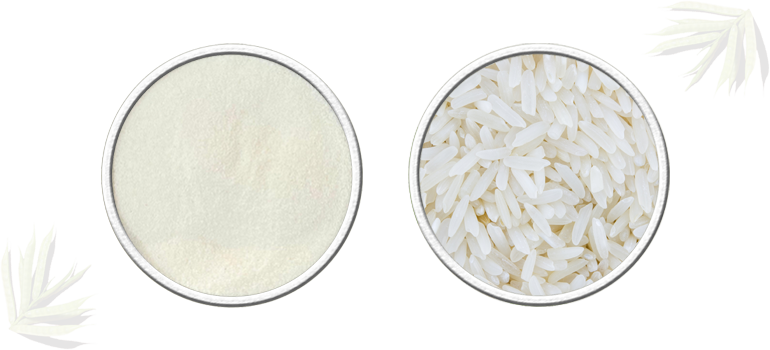Rice Flour

Rice Flour
Rice has been a staple food source around the world for centuries, especially in eastern cultures. Rice is eaten by over half of the world population and provides 20% of the world's dietary energy supply. Rice is a valuable source of energy, as well as carbohydrates, potassium and thiamin.
Rice flour is primarily made from polished broken rice. Rice flour, sometimes called rice powder, is made from finely milled white raw rice and is used to make fresh rice noodles and sweets. It is also used to thicken coconut milk to a rich, smooth and creamy consistency. The rice flour is easily available in most Asian markets. Rice flour has previously been used in food products for baby foods. Today the rice flour has extensive use in many recipes. Rice flour is being used in cereals, crackers, chips, snacks, and coating applications to provide different textures.
In recent years, the benefits of rice flour were discovered and the so the usage in new applications began growing dramatically in India, Japan, Southeast Asia, Thailand and USA. Rice flour is ideal for people having special dietary requirements as it has no gluten, fat and cholesterol and so it has been proven to be a perfect intake for gluten intolerant people.
Rice flour can be digested easily compared to other flours and it has light and fluffy qualities. It is also an excellent thickener for sauces, gravies and custards.
Rice flour is compatible to many wheat flour recipes and is also used as a thickening agent in refrigerated or frozen recipes. Manufacturers of food products, chefs and cooks have realized the nutritional value of rice flour and have replaced wheat flour with rice flour in many recipes.
Our Rice Flour is manufactured from finely milled white raw rice and is available in various size of packaging. We are offering wide range of Vacuum Packed Rice Flour. Rice flour are processed using high quality polished broken raw rice and are widely known as rice powder.
Applications
- Baby Food
- Meat Coating
- Bakery
- Sausages
- Snacks
Features
- GLUTEN FREE
- Superior quality
- Appropriate packaging
- Hygienically processed
- Packing : 25 kg Vaccum bags
- Quantity in 1 FCL : 800- 840 bags.
Technical Specification
| Sr. No. | Grade | Coarse | Medium | Semi-Coarse | Fine | Super Fine |
| Chemical Parameters | ||||||
| 1 | Moisture | 9 – 14% | 9 – 14% | 9 – 14% | 12% Max. | 12% Max. |
| 2 | Gluten | < 5 PPM | < 5 PPM | < 5 PPM | < 5 PPM | < 5 PPM |
| Granulometry | ||||||
| 3 | Retained on | 500 μm: 5% Max. | 425 μm: Nil | 425 μm: Nil | 150 μm: 10% Max. | 75 μm: 10% Max. |
| 4 | Retained on | 425 μm: 5-25% | 212 μm: 0-5% | 212 μm: 15% Max. | - | - |
| Microbiological Parameters | ||||||
| 5 | Standard Plate Count | <100,000 per gram max. | <100,000 per gram max. | <100,000 per gram max. | <100,000 per gram max. | <100,000 per gram max. |
| 6 | Coliforms | <200 per gram max. | <200 per gram max. | <200 per gram max. | <200 per gram max. | <200 per gram max. |
| 7 | Yeast & Moulds | 2000 per gram max. | 2000 per gram max. | 2000 per gram max. | 2000 per gram max. | 2000 per gram max. |
| 8 | Bacillus Cereus | 1000 per gram max. | 1000 per gram max. | 1000 per gram max. | 1000 per gram max. | 1000 per gram max. |
| 9 | E-coli | 10 per gram max. | 10 per gram max. | 10 per gram max. | 10 per gram max. | 10 per gram max. |
| 10 | Salmonella | Not Detected in 25 grams | Not Detected in 25 grams | Not Detected in 25 grams | Not Detected in 25 grams | Not Detected in 25 grams |
Packing :
- 25 Kg Vacuum Sealed Bags.
- 25 Kg / 30 Kg / 50 Kg HDPE Laminated Bags.
Storage Conditions :
- Storage must be in an area that is clean, dry, cool, well ventilated, away from direct sunlight and from any oily or odorous material & toxic chemicals.
- The area must have pest control program in place to prevent rodent & insect infestation.
Disclaimer :
- User are advised to make their own tests to determine the safety & suitability of each product or product combination for their own purposes. Read and understand the material safety data sheet (MSDS) before using this product.


